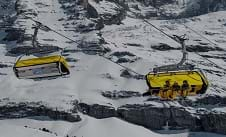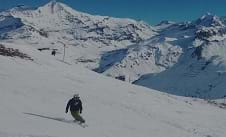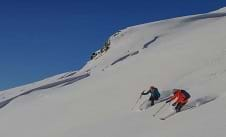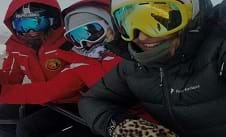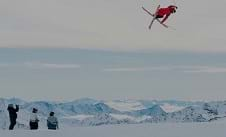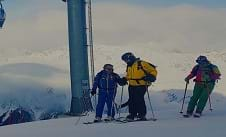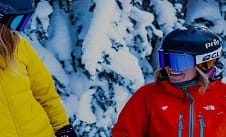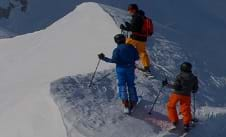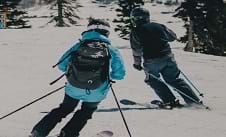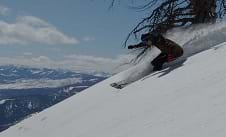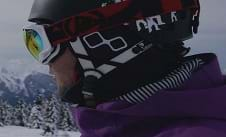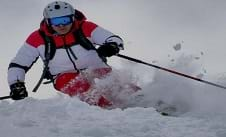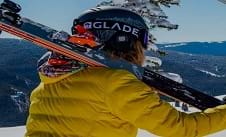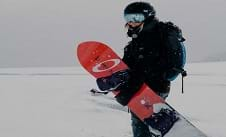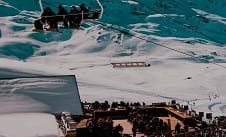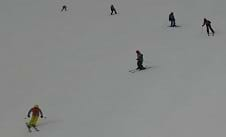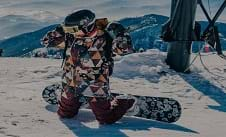Ski boots guide
Did you know women tend to have a bigger, lower gastrocnemius muscle than men? But what does that mean? Essentially it means their lower calves sit lower than men’s (who have a longer soleus muscle) and having a flared cuff on ski boots tends to be more comfortable. What we’re getting at is, when it comes to boots, one size does not fit all and the single best piece of advice we can give is to get fitted by a professional because a poorly fitting boot can put you off skiing for good.
It can seem expensive, but a comfortable, responsive boot is a better investment than skis themselves for most people. Your boots are one of, if not the most important, kit elements you can own and will significantly impact your holiday experience. Unfortunately, like anything technical, there’s a lot of jargon and aspects to consider before parting with your cash. We’ve outlined some of the common areas you’ll want to consider and broken down some of the techy terms you’ll come across.
with your own travel concierge. Don’t hesitate to drop us a line – we’ll
help plan your perfect Ski Holidays.
020 7770 6888 ← online or call ↴
020 7770 6888
Skier ability
Your ability will play a big part in the type of boot to go for. A newer skier typically benefits from a softer, more forgiving fit that allows the focus to fall on posture and technique. With progression, stiffer boots boost performance by allowing power more transfer to the ski and great response.
Be honest with your ability - don’t just buy super stiff, performance race boot if you’ll be spending your time on gentle blues as it’ll just hamper your enjoyment and development.
Ski boot size
It’s not quite as simple as just knowing your shoe size when buying ski boots. Ski boots need to fit the foot exactly, so you’ll need to know your Mondo Point measurement. We recommend getting a professional to measure you to discuss your riding style, performance requirements and get advice on fit adjustments.
To get the Mondo Point measurement at home, you need to:
- Put a piece of paper against the wall
- Put your foot on the paper with your heel against the wall
- Bend at the knee to simulate the ski position
- Draw around your foot
- Measure the longest distance
Don’t be worried if your toes touch the front of the boot when they first go in as once the buckles are done up your foot will be put into the correct position.
Ski boot width
Feet are all different, so it’s essential to work to your requirements. Boot width (sometimes referred to as ‘last’) is measured across the forefoot. Custom-fit insoles and mouldable shells can tailor a fit to your foot, but you need to get the right start point.
Ski boot widths:
- Very narrow fit 92mm - Usually the preserve of racers
- Narrow fit 96mm – 98mm - For narrowed footed riders with low volume foot, or if you’re looking for precision over comfort.
- Average fit 100mm - Most skiers fall here
- Wide fit 102mm or very wide fit 104mm+ - For those with wider feet and a higher volume.
A boot that’s too wide can hamper your ability to control your skis and provide insufficient support for your foot. Performance skiers sometimes opt for narrower boots at the cost of comfort.
Flex
Flex is a measurement of the boot’s rigidity or stiffness. Simply put it is how it easy it is to bend the cuff forward. The recommend flex profile of a boot differs based predominantly on ability, gender, and the type of riding you’ll be doing.
Flex ratings for men and women:
- Beginner: Men 60 – 90 // Women 60-70
- Intermediate: Men 90- 110 // Women 70-90
- Advanced: Men 110+ // Women 90+
It’s important to take a couple of elements into account when choosing flex:
- Your weight/strength. A heaver or stronger rider will likely want a stiffer boot.
- The terrain you’ll be riding.
- Your progression speed.
Ski book terminology
Stiffness
Commonly referred to as flex, this is the scale of how hard or soft the boot is. A softer, flexible boot may be more comfortable and forgiving for a newer skier. In contrast, a stiffer boot has more resistance when driving hard into turns, giving more power transfer, performance, and precision than a softer boot. Weight, terrain and ability are all significant factors in deciding on the best flex for you as a skier.
Last width
The last width is effectively the width of the boot at its widest point. Typically, this will be across the forefoot/ball of the foot area.
Velcro Strap
Most boots come with a Velcro strap around the cuff area, which is used in conjunction with the buckles to help tinker with the boot's fit/feel. Velcro straps (sometimes branded as a booster or power strap) can also add to the 'rebound' feeling when putting pressure through the cuff.
Custom fit liner
These are the boot's internal liners that can be customised to your foot and work well for people with 'lumpy' or 'boney' feet, or with features like high bridges, by relieving pressure and adding support not found in stock liners. You'll find various methods like foam injection or heat moulding used to get a bespoke fit.
Custom fit shell
This refers to the hard-outer shell that can be moulded for great comfort or performance. Usually, the boot will be heated so it pliable then any pressure areas can be stretched or shaped to your foot's profile.
Mondo Point
Your Mondo Point size is a universal measurement used in the ski industry to determine boot size. If your foot is 285mm long, your Mondo Point size will be 28.5, 300mm will be 30, 255mm will be 25.5, etc. Check in the size part of this guide to see how to measure for Mondo Point.
Ski socks
Always make sure you’re wearing your big thick ski socks to get fitted, right? Not necessarily. Most boot fitters recommend a thinner (but still warm) regular sock for these reasons:
- Thick socks can lead to boots that are too big.
- More padding between your leg and boot (big socks, then the liner, then boot) can hamper control and dampen the response.
- Wedging thick socks tightly into the liner can restrict blood flow, making you colder. Warm liners provide excellent insulation, so trust them or try going for some thermal ones.
If you’re getting professionally fitted, talk to them about the socks too. They’ll help work out the best combo of boot, liner and sock for you.
Preferred terrain
Different terrains will have different demands out of your ski equipment. Most boots will work for leisurely piste skiing, but for added performance on groomed runs a higher cuff, closer fitting and stiff boot will enable you to drive more power into your turns. All mountain skiers and freeriders will benefit from rigid and a more responsive boot, whereas a freestyle skier will prefer a softer, more forgiving boot to help with impact absorption. Other considerations are features like a ‘walk mode’ which will be useful for freeride and touring skiers.
Ski boots FAQ:
Most ski bags are designed for one set of skis/poles without room for much else. You can purchase a separate ski boot bag which can often be taken as hand luggage on certain airlines. If you can't take them as hand luggage, you will have to check them in instead. Ski boot bags can provide extra padding to keep your boots protected during travel.
You can buy basic ski boots for less than £100, which can be cheaper than renting ski boots for a week skiing. For top-end ski boots, you’re looking at as much as £700. For a reliable, long-lasting pair of ski boots, you wouldn’t need to pay more than £250.
There are many elements to custom ski boots – from x-raying your feet to find the perfect fit boot for you to heat moulding the boot's liner or shell. For the customisation part alone, excluding the off-the-shelf boot cost can be up to £500.
At the end of the ski season, there are some great deals to be had on ski boots. Look out for sales on ski equipment in March and April. Another great time to purchase ski boots is over summer as shops are trying to get rid of last years' stock to take on new technology.
Ski boots are specifically designed for controlling your skis down the slope. They have a hard (usually plastic) outer shell with a softer liner for comfort. They are designed to clip into your skis by the toe and heel of your boot.
No. You only wear long thin ski socks in your ski boots. When skiing was first invented, ski boots weren’t around so you would wear shoes strapped directly onto your ski.
To clean the shell of your ski boot, you only need to wipe them down with a wet cloth. It’s worth drying them after by wiping with a dry cloth and leaving them out as they can deteriorate when left wet.
When cleaning your ski boot liners, the best method is to hand wash them. Make sure you leave them out to dry after or they will smell like damp.
The best way to get your ski boots fitted correctly is to see a professional. Branded ski boots are designed for different shaped feet, so it is essential you know what ski boots best suit your feet.
More experienced skiers prefer a tighter fitting boot that can be uncomfortable whereas many holidaymakers would prefer a slightly larger boot than their exact size for comfort.
Keeping your feet warm in ski boots can be quite a challenge. Wearing thin socks is the easiest way to do this. By wearing thin socks, you create extra space in your ski boots for airflow, which will keep your feet warm. Alternatively, you can purchase specific feet warmers which slide under the sole of your foot and radiate heat throughout the day.
While highly recommended, it is not essential. If you feel like you’ve got enough space in your hold luggage, then you can pack them along with your clothes. Remember ski boots aren’t light - on average ski boots weigh 5KG for a pair.
Each airline has different rules on the dimensions of their hand luggage. I have taken my boots as carry-on many times to save paying for an extra bag on the flight, but you must always check your airlines' baggage allowance rules first.






